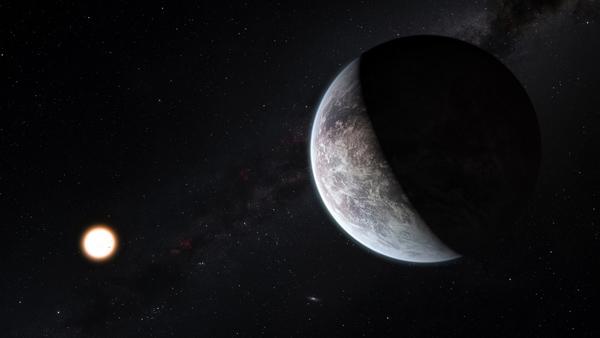How to Search for Life on Alien Planets

Earlier this week, astronomers announced that they had discovered more than 50 new extra-solar planets, and 16 of these alien worlds have been classified as so-called super-Earths. One of the super-Earths, dubbed HD 85512b, has excited astronomers the world over because it sits at the edge of its parent star's habitable zone, suggesting favorable conditions that could support life.
But why is this planet's particular position so important for life? And if there is life on HD 85512b , how might astronomers go about confirming its existence?
The Habitable Zone
Also known as the "Goldilocks zone," the habitable zone is the region of space around a star that is just right for liquid water and life as we know it to exist on an orbiting planet's surface (the temperature in this zone is not too hot to boil away water and not too cold to freeze it). This region is different for each star and depends on the amount of radiation heat and otherwise that the star emits. Astronomers can calculate the radiation of a star using its size and effective temperature, explained Jon Jenkins, who heads the analysis efforts for NASA's Kepler mission, a project that is hunting for habitable planets in our galaxy. "It's not a terribly difficult calculation," he told Life's Little Mysteries. [How Do Astronomers Find Alien Planets? ]
Of course, it takes more than just being in a star's habitable zone for a planet to be "habitable." While astronomers haven't exactly ruled out Jupiter-like gas giant planets as being able to harbor life, they typically think that habitable planets will be terrestrial (rocky) in nature, with less than 10 times the mass of Earth. But a planet can't be too small either a planet with a fraction of the Earth's mass would be unable to gravitationally hold on to an atmosphere (though current technologies are unable to detect such low-mass planets anyway). HD 85512b meets these conditions as well: It is about 3.6 times the mass of Earth, a comfortable size for a habitable planet.
Analyzing atmospheres
Once astronomers discover a terrestrial planet in the habitable zone of a star, the next step is to analyze its atmosphere for clues of life. Unfortunately, reading the atmosphere of HD 85512b and other super-Earths currently isn't possible: today's technologies are only able to inspect the atmospheres of large, Jupiter-size planets that are very close to their stars.
Sign up for the Live Science daily newsletter now
Get the world’s most fascinating discoveries delivered straight to your inbox.
But the process is fairly well-oiled, and once technology allows for it, here's how astronomers would scan for life on the newly found super-Earths:
The first step for detecting biomarkers in a planet's atmosphere is to compare the spectrum of a star that is, the different wavelengths of light coming from it alone with the spectrum of the star while a planet is in front of it. If a transiting planet doesn't have an atmosphere, it will block out the same amount of starlight at all wavelengths.
On the other hand, if a planet does have an atmosphere, the gases in it will absorb the star's light at specific wavelengths. Astronomers can infer from these absorption patterns the different types of atoms and molecules, such as oxygen and nitrogen, that constitute the atmosphere.
If astronomers analyze the atmosphere of a planet and find a bounty of oxygen, this could be a good indicator of life: Molecular oxygen is volatile, and it would therefore need to be constantly replenished by some active process in order to exist at any significant quantity. Of course, this is not a slam dunk for life, as some non-biological processes, such as the runaway greenhouse gas effect on Venus, can also produce oxygen-rich atmospheres.
According to Jim Kasting, a planetary scientist at Pennsylvania State University, rather than just finding oxygen, the "holy grail of remote life detection" would be to discover large quantities of both oxygen and methane (also a byproduct of life). Kasting, who wrote the book "How to Find a Habitable Planet" (Princeton University Press, 2009), explained that oxygen and methane do not exist together in high quantities, so detecting a lot of the molecules together in a planet's atmosphere would be a strong indicator that the planet harbors life. [What Are the Ingredients of Life? ]
So while HD 85512b might, in fact, be well positioned to provide a home for life, as of now, scientists can't yet examine its atmosphere for supporting evidence.
For now, the best way to search these new super-Earths for signs of life will be to listen to them with SETI radio telescopes.
Looking toward the future
Astronomers are looking toward future technologies and methods to solve their extraterrestrial life-hunting needs, such as NASA's proposed Terrestrial Planet Finder. The project outlined a couple of methods that could directly image an extra-solar planet. One of the techniques involves a very large space telescope with special optics to block light from a star, which would allow astronomers to study the properties of any orbiting planets, Jenkins said.
The project was recently canceled by NASA, disappointing some astronomers, but could it be revitalized? Kasting seems hopeful, and said that astronomers first need to acquire the funding necessary to test the technologies of the Terrestrial Planet Finder. Funding, he pointed out, starts with getting the word out. "I want as many people as I can to know about TPF," he said.
- A Field Guide to Alien Planets
- Top 3 Questions People Ask an Astrophysicist (and Answers )
- Are We Alone in the Universe? New Analysis Says Maybe
Follow Life's Little Mysteries on Twitter @llmysteries, then join us on Facebook.











